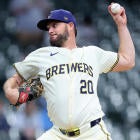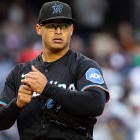The 2016 Diamondbacks have a little 2013 Blue Jays in them. Toronto went all-in on 2013, trading away many top prospects (Noah Syndergaard, most notably) to add Jose Reyes, R.A. Dickey, Mark Buehrle, Josh Johnson, and others to Jose Bautista and Edwin Encarnacion. They also signed Melky Cabrera. The result? A 74-88 record and fifth-place finish in the AL East.
The D-Backs also went all-in this past offseason. They signed Zack Greinke to a record contract and traded a stunning package of young players for Shelby Miller. They also brought in Jean Segura and Tyler Clippard. The goal was to add those players to a core that included Paul Goldschmidt and A.J. Pollock, and make a run at the NL West title, which looked up for grabs.
Instead, the D-Backs come into Saturday in last place in the division, owners of a 38-50 record. They're 17 games back of the Giants in the NL West and 10 games back of the second wild card spot with eight teams ahead of them. Only the unabashedly rebuilding Reds and Braves have a worse record in the NL than the D-Backs. The "all-in on 2016" plan has failed miserably.
Now GM Dave Stewart and chief baseball officer Tony La Russa are left to pick up the pieces on a lost season. They started the process early Saturday morning by trading closer Brad Ziegler, an impending free agent, to the Red Sox for two prospects.
Where do they go from here? Here are some ideas.
1. Keep selling!
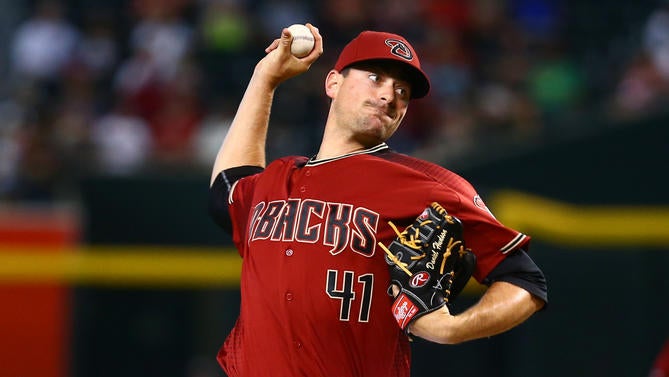
Arizona does not need to tear things down and completely rebuild. They have a good core led by Goldschmidt, Pollock, Greinke, Segura, and Jake Lamb. That's a core you can build around going forward and plan to contend with as soon as next season, assuming the rest of the roster is improved.
The D-Backs traded away Ziegler because a bad team doesn't need a good closer. He was going to be a free agent after the season, and keeping him for the second half would have been silly. Arizona shouldn't stop selling there though. They have some other pieces to move:
- RHP Daniel Hudson: Hudson, another impending free agent, has a 4.06 ERA and 96 strikeouts in 99 2/3 innings as Ziegler's primary setup man since returning from his second Tommy John surgery two years ago.
- RHP Tyler Clippard: Clippard's strikeouts (10.9 K/9) have returned following his down 2015 season (8.1 K/9), plus he's signed through next season on an affordable deal. That said, that cheap contract is also a reason to keep him.
- RHP Josh Collmenter: Collmenter is yet another impending free agent, and while he's having a poor year (6.35 ERA with an 11/10 K/BB in 17 innings), he has a strong track record as a rubber-armed swingman.
- UTIL Chris Herrmann: Herrmann has been a revelation with Arizona, hitting .293/.355/.514 (125 OPS+) in 156 plate appearances as a part-time catcher, first baseman, and outfielder. Both his BABIP (.372) and track record (47 OPS+ from 2012-15) suggest this is a small sample fluke, however. The D-Backs should cash Herrmann in as a trade chip before he reverts back to his career norms.
- C Welington Castillo: Catching help is hard to find, and Arizona has some alternatives to Castillo in Herrmann and Tuffy Gosewisch, and maybe former Rule 5 Draft pick Oscar Hernandez. Castillo, who is hitting .272/.315/.448 (97 OPS+), could bring a nice return from a catcher-needy team.
Yasmany Tomas, the team's regular right fielder, should be made available as well given his underwhelming production (94 OPS+) and big contract (owed roughly $60 million through 2020), though that contract figures to be an obstacle.
Point is, the D-Backs have some useful spare part players in guys like Hudson and Clippard and Herrmann, and they should look to capitalize on their trade value while they can. No, they're not going to bring back future stars or anything, but moving them helps add depth and clear payroll, two things that will be useful in the future.
2. Send Miller to the minors.
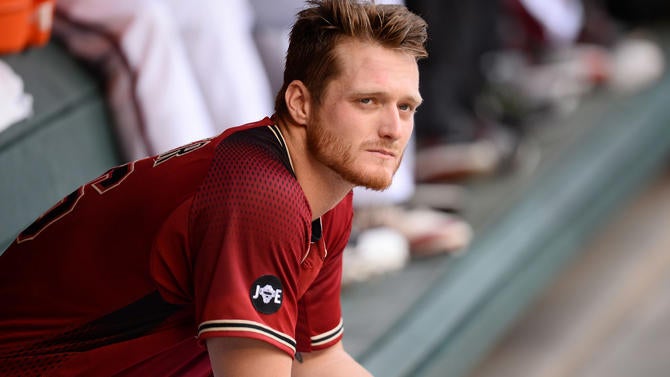
Even the biggest Shelby Miller doubters did not see this coming. Miller, who was a deserving All-Star last season, has been a mechanical mess all year, and the result is a 7.14 ERA (61 ERA+) and a 1.75 WHIP in 69 1/3 innings. A recent stint on the DL hasn't helped matters; Miller has allowed 19 runs in 23 2/3 innings since returning.
Trading Miller just to dump the headache is not advisable. The D-Backs paid a huge price to get Miller over the winter and it wouldn't make sense to sell so low on him now, after only half a season. Arizona has to get him right. It should be priority No. 1 at this point, and that process should take place in Triple-A. Getting blasted every fifth day in the majors does neither Miller nor the D-Backs any good.
Ideally Miller would go to extended spring training, where it's easier to work on the side with various pitching instructors, but extended spring training ended a few weeks ago. Triple-A is the next best option. Miller can step back, catch his breath, and reboot a bit after such a miserable first half. He'll be able to work on his mechanics at his pace and out of sight, not in games that count.
Also, sending Miller to the minors for roughly 42 days will push his free agency back one year. Right now he's scheduled to hit the open market after the 2018 season. Forty-two days in the minors would delay Miller's free agency until after the 2019 season. Miller and his representatives at CAA Sports will not be happy about that at all, but there are two things about this:
- The demotion would not be undeserved. I get Miller was an All-Star last year and a highly touted prospect back in the day, but guys who pitch to a 7.14 ERA in 69 1/3 innings usually don't get to stay in the majors. That performance is 100 percent demotion-worthy. This is a baseball move, not a move designated to manipulate service.
- If Miller doesn't get his mechanics right, free agency might not matter. Like I said, the priority should be getting Miller right, both from the team's perspective and Miller's (and his agent's) perspective. If he continues to struggle with bad mechanics, becoming a free agent in two-and-a-half years won't matter. The big contract won't be coming.
It was worth it to see how Miller would respond following the DL stint -- he was out with a right finger sprain, officially -- and there was no change in his performance, unfortunately. It's time to send him down to the minors so he can focus on getting himself back on track and not worry about winning ballgames.
3. Give O'Brien an extended look.

Slugger Peter O'Brien, who Arizona acquired from the Yankees in the Martin Prado trade two years ago, is one of the most prolific home run hitters in Triple-A. Over the last two seasons he's hit .295/.336/.583 with 44 home runs in 185 Triple-A games. Two years ago he hit 34 homers in only 106 games between high Class A and Double-A.
The D-Backs brought O'Brien up for a few weeks earlier this season, during which he hit .123/.167/.333 (27 OPS+) with four homers and 25 strikeouts in 60 plate appearances. Most of the home runs looked like this:
Moonshots. The kid hits nothing but moonshots. Few players in the game can match O'Brien's raw power.
The question is whether O'Brien will make enough contact to tap into that power at the next level, and where exactly he'll play. He started his career as a catcher, but that didn't last. Nowadays O'Brien is a left fielder because there's no DH in the NL and Goldschmidt isn't going anywhere at first base.
The D-Backs are currently playing scrap heap pickup Michael Bourn in center and a combination of Herrmann, Phil Gosselin, Brandon Drury, and Rickie Weeks in left field. Of those five players, only Drury figures to have a long-term place with the D-Backs as something more than a role player. Making room for O'Brien won't be too difficult.
O'Brien, who turns 26 next week, may not be anything more than a Quad-A masher along the lines of Shelley Duncan and Carlos Peguero, but the D-Backs are never going to find out unless they give him a long look as an everyday player. Sometimes those players turn into Russell Branyan or Jack Cust and put together some productive seasons.
We know O'Brien crush Triple-A pitching. It's time to see if he can handle big league pitching too.
4. Approach Lamb about a long-term extension.
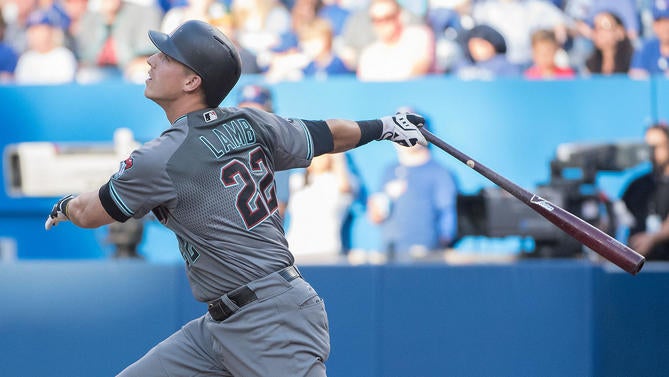
Although he did not win the Final Vote, third baseman Jake Lamb is having an All-Star-caliber season, hitting .291/.373/.621 (154 OPS+) with 20 home runs in 84 games. He leads the NL in slugging percentage and is behind only Red Sox DH David Ortiz (.682!) in all of MLB. Simply put, Lamb is breaking out as one of the top power hitters in baseball.
Because he is only 25, Lamb is part of the solution for the D-Backs. He can be part of their next contending team, one that not only gets into the postseason, but has a chance to make a deep run. When Arizona realized Goldschmidt was that type of player as well, they wisely locked him up to a five-year extension worth $32 million. That deal also includes a $14.5 million club option for a sixth year.
The Goldschmidt deal is one of the best values in all of baseball, and the D-Backs were able to strike such a team-friendly deal because they acted quickly. Goldschmidt signed that contract in March of 2013, after his first full season in the majors, during which he hit 20 homers with a 126 OPS+. He's been an All-Star each year since and has twice finished as the runner-up in the NL MVP voting.
Salaries have gone up since March 2013, so getting Lamb to agree to a deal similar to Goldschmidt's probably won't happen. Also, it's worth noting Lamb has more service time now that Goldschmidt did at the time of his extension. Here are two recent examples of infielders signing long-term at a similar service time level as Lamb:
- Matt Carpenter, Cardinals: Six years, $52 million with an $18.5 million club option for a seventh year.
- Jason Kipnis, Indians: Six years, $52.5 million with a $16.5 million club option for a seventh year.
The Cardinals and Indians are very happy they locked up Carpenter and Kipnis, respectively, when they did. A similar deal for Lamb, six years and $52 million or so, would keep him in Arizona through his peak years at what figures to be a below-market salary.
Power pays big in arbitration, and with the way things are going now, Lamb is setting himself up for a nice payday down the line. As they did with Goldschmidt, the D-Backs would be wise to get out of front of Lamb's true peak years and sign him long-term. He's a cornerstone player, and those are the guys you go out and lock up.
The D-Backs are no doubt disappointed with the way things have played out this year. They came in 2016 with plans of contention and it hasn't worked out at all. But, as those 2013 Blue Jays showed, one disappointing season doesn't have to derail the franchise. Toronto won their division two years later thanks in part to the foundation they built in 2013.
Arizona has a chance to do something similar. They might not win this year, but they have the makings of a contender with Goldschmidt, Lamb, Greinke, Pollock, and others. The D-Backs almost certainly will not make the postseason this year. They should instead view the second half as an opportunity to set themselves up for contention in the future.



















